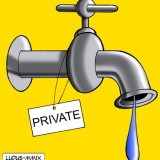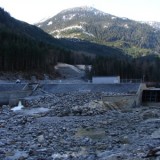World Water Day (March 22nd) is a good time to consider this: Canada has nearly 10% of the world’s supply of fresh water. How lucky are we?
But what is all this water doing to earn its keep? Nothing. Or so think our politicians – and thirsty corporations like General Electric.
In 2010, GE (according to Council of Canadians, the world’s largest water company) and Goldman Sachs (uh, oh) co-founded the World Resources Institute Aqueduct Alliance. The basic purpose of the alliance is to map (and presumably lay hands on) the global supply of fresh water. After all, as the alliance points out, “In many regions around the world, water scarcity from climate change and pollution is starting to impact a company’s performance.”
Within a year the expanded alliance included Coca-Cola, Calgary-based Talisman Energy, Dow Chemicals and United Technologies, the world’s 10th largest arms producer. (Knowing where water shortage conflicts might appear could, after all, be useful.)
Oh, what a web these companies weave.
In Alberta, the president of GE Canada was a member of the Premier’s Council for Economic Strategy which last year recommended the creation of a new Alberta Water Authority. The new authority would facilitate buying and selling of water licences.
According to the council’s report, the authority would “also advise on policy changes to give holders of water licenses more opportunity to sell, lease or trade some or all of their right to draw water. Such changes will allow licensees holding water allocations they are not currently using or no longer need to lease or sell this surplus to others within the watershed at a price set by market forces of supply-and-demand.”
How bad could that be?
Ask the government of Australia. In the 1990s exactly this sort of water market was established for the Murray Darling River Basin. A 2001 drought started a water-rights speculation frenzy. By September 2010, the Australian government had spent nearly $1.5 billion buying back water rights at inflated free market prices.
Here in BC (where Talisman Energy already has a licence to divert up to 10,000 cubic metres (10 million litres) from the Williston reservoir every day for the next 20 years), similar plans are afoot.
The provincial government is expected to table a new Water Act in 2012. It is anticipated that the new Act will allow water licence owners (whatever the purported use licensed) to sell to the highest bidder. The new owner can arbitrarily change the licensed use from, say, agriculture to heavy industry. In a drought such as Australia’s, good luck to farmers who might need to buy water back.
Welcome to the deregulated water market.
Companies like Brookfield Asset Management (BAM) love it. BAM, one of two companies which shared ownership of most of BC’s public land forests and all the private land forests, is keen to get into the hydroelectricity game. (FYI, BAM director J. Trevor Eyton is also a director of Coca-Cola Enterprises.)
We sell them the rights to our water and they sell us their electricity. No wonder EcoJustice describes BC’s proposed Water Act as a pretty sweet deal for industry.
Yes, of course most industries require water and, within reason, they should have access to it. However, instead of turning our water rights into tradable commodities, how about we maintain control of our water for the public good?
Here’s a crazy idea for World Water Day. Industries could pay for the water they use by volume. Companies might decide to reduce the water they currently waste and that would be a bonus. Whether or not they do, the people of BC could be paid a fair fee for a precious resource. Instead of paying for corporate bonuses, the money could, oh, I don’t know, pay for health care and education? Perhaps some of the revenue could be used to upgrade our crumbling infrastructure.
Or we could carry on with plans to more or less just give our water rights away.
Miranda Holmes is an associate editor of Watershed Sentinel magazine. For more information on this topic, go to www.watershedsentinel.ca/content/ge-and-privatization-water






